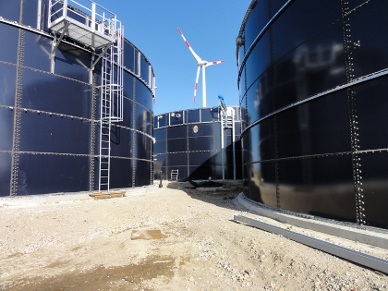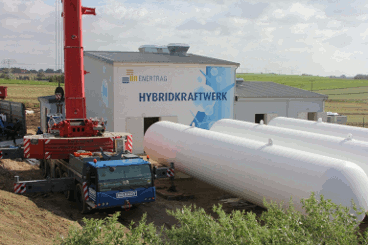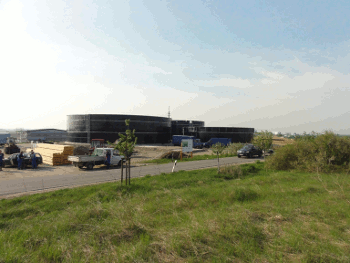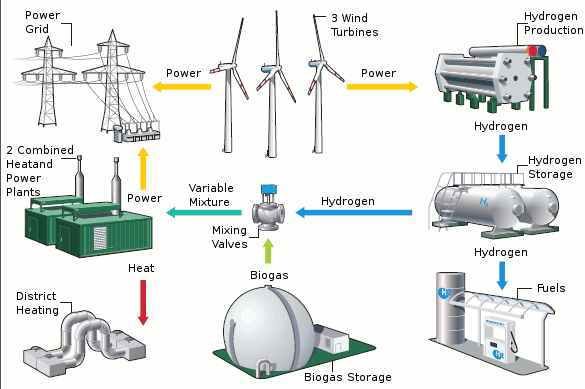First European Hybrid Power Plant Converting Wind Power to Hydrogen Fuel

Wind Turbine behind Tanks at Prenzlau
Hydrogen power could be one of the solutions to our future energy needs, but until recently the problem with hydrogen power was its production for use as an energy source. Although hydrogen is the most common element in the known universe, actually capturing it for energy use is a process which itself usually requires some form of fuel or energy.
By far the most common method of produciing hydrogen currently is to strip hydrogen from natural gas using a process known as steam reforming. 95% of the world's hydrogen for energy usage is produced this way. Steam reforming of natural gas requires temperatures as high as 850 degrees celsius and pressures of up to 365 pounds per square inch (25 bar). If we're aiming for a sustainable future, creating hydrogen this way from the world's finite resources of fossil fuels isn't going to be the answer.
An alternative to steam reforming is to produce hydrogen by electric hydrolysis. This is a relatively simple method which you may have seen in chemistry lessons at school. Two electrodes - a positively charged anode and a negatively charged cathode - are run from a battery into water. The electic current splits the hydrogen and oxygen in the water, with the positive hydrogen ions being attracted to the cathode, and the negative oxygen ions going to the anode. Once the ions touch the electodes the hydrogen gains an electron (and the oxygen loses electrons), creating fully-fledged atoms of hydrogen and oxygen, which then rise in the water to be collected separately at the top.

Hydrogen Storage Tanks at Prenzlau
A major advantage of hydrolysis is that it produces hydrogen in a clean way. The problem is that it needs a source of the electrical power in the first place. A new working project in Prenzlau, 75 miles North of Berlin in Gemany aims to combine the advantages of wind power and hydrogen to overcome the problems of both forms of power production and to embrace the advantages

Prenzlau Wind to Hydrogen Site
Hydrogen is considered to be the main choice for storing renewable energy, as it is easily transported and stored in large amounts.
The three wind turbines at the Prenzlau project can each produce 2 Megawatts of power. Based on an estimation that 1 megawatt can supply enough power for 240 to 500 households, WindUpBattery estimates that the three turbines together should therefore be able to supply enough energy between them to power between 720 to 1500 homes, assuming a contant wind. As we all know, the wind isn't constant and reliable though, so when it comes to the future power companies working out how many homes should be powered by a certain number of wind turbines, the calculations need to take into consideration periods of low wind. This, combined with the fact that people don't use a set amount of electricity constantly, but instead vary their demands during the day, means that there is always the possibility of differences between supply and demand.

Prenzlau Wind to Hydrogen Production Diagram
Interestingly, according to Vattenfall, one of the energy companies participating in the Prenzlau project, currently the is no system within the renewable energy sector which is designed to compensate for supply and demand differences. Wind farms produce energy which is fed directl into the power grid but the challenge is to develop and employ a way of storing the energy when wind power production is greater than demand. The Prenzlau project enables a balance to be found in the renewable energy production system. Operating on the 6 megawatt that it providess, this is the first full scale European hybrid power plant to convert the variable nature of wind power to hydrogen for a reliable long-term renewable energy source for general electrical usage and for use in hydrogen fuel cell powered cars and other transport, as well as for heat to co-fire the power plant itself.
From the three 2 Megawatt wind turbines the electrical power can either be fed staight into the Power Grid, or to an electrolysis unit which is used to produce the hydrogen. This is stored in the plant's hydrogen storage tanks. From there the hydrogen can then be fed along the system and mixed with biogas from a separate unit at the project, and this mixture can be used to run two combined heat and power plants to produce both electricity for the Power Grid and district heating at times when high demand coincide with low wind power production.
Alternatively the hydrogen from the storage tanks can be used at vehicle filling stations in Hambutg and Berlin which are run by the Total energy company to supply fuel cell cars and other vehicles. Total has been testing the use of hydrogen filling station for around 10 years in Berlin to fuel clean transport with no carbon dioxide emissions.
Vattenfall and other partner companies are planning to extend this pilot project to several major future projects for creating and storing hydrogen from wind energy, including one in the German state of Brandenburg.
Photos and wind to hydrogen production diagram courtesy of Enertrag, one of the partner companies at Prenzlau.

- Renewable Energy:
- Login to post comments

